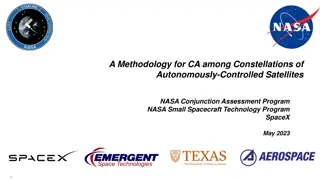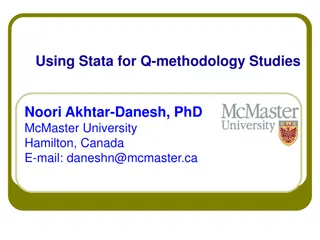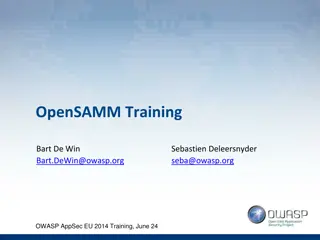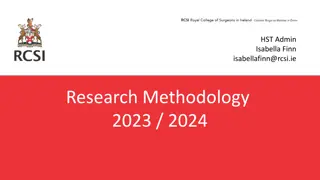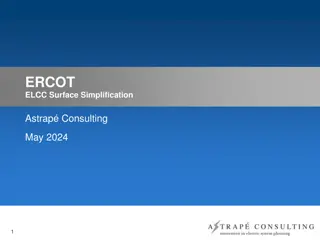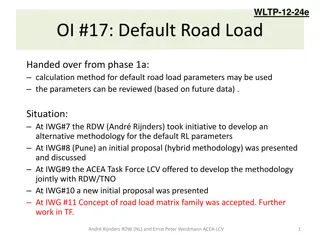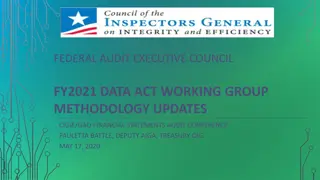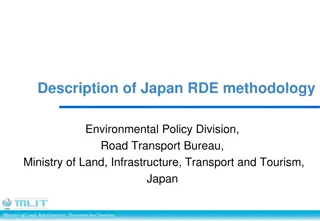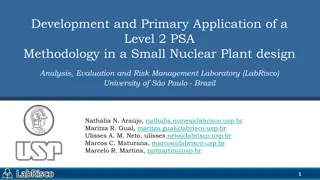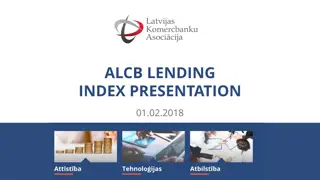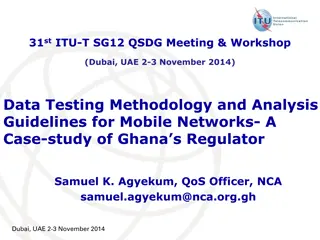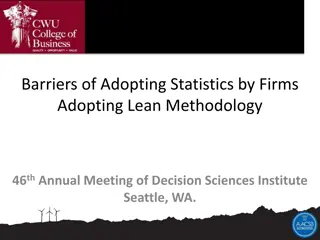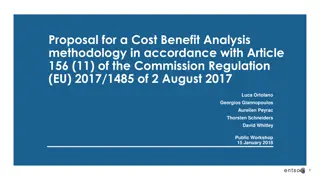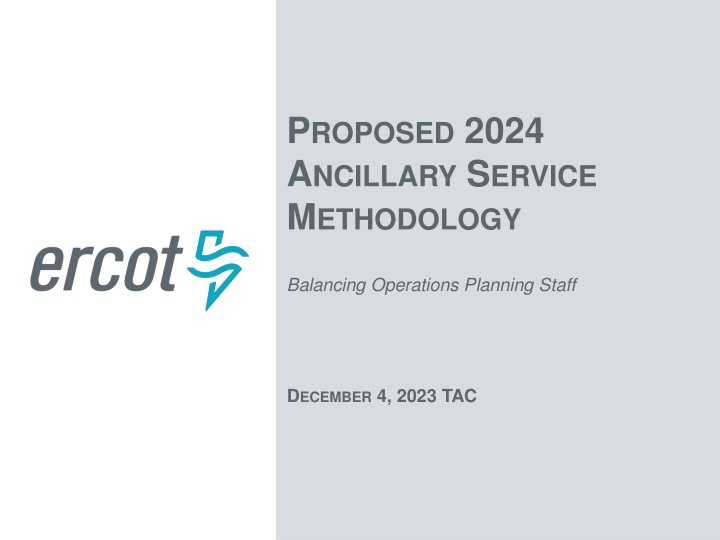
2024 ERCOT Ancillary Service Methodology Review Summary
"Discover the proposed changes in ERCOT's 2024 Ancillary Service methodology, including Regulation Service tweaks, RRS adjustments, ECRS modifications, and Non-Spin updates. Explore the timeline and key updates for the upcoming year."
Download Presentation

Please find below an Image/Link to download the presentation.
The content on the website is provided AS IS for your information and personal use only. It may not be sold, licensed, or shared on other websites without obtaining consent from the author. If you encounter any issues during the download, it is possible that the publisher has removed the file from their server.
You are allowed to download the files provided on this website for personal or commercial use, subject to the condition that they are used lawfully. All files are the property of their respective owners.
The content on the website is provided AS IS for your information and personal use only. It may not be sold, licensed, or shared on other websites without obtaining consent from the author.
E N D
Presentation Transcript
PROPOSED 2024 ANCILLARY SERVICE METHODOLOGY Balancing Operations Planning Staff DECEMBER 4, 2023 TAC
Introduction ERCOT has reviewed the methodology to determine minimum Ancillary Service (AS) requirements. Following is a summary Methodology for 2024. Regulation Service changes. The Net Load variability calculation will be tweaked to include additional accounting based on accumulated Area Control Error (ACE) to better reflect the balancing needs from the hour. Responsive Reserve Serve (RRS) Methodology: One change. Remove the 2,800 MW floor that is applied to summer peak hours. A Minimum 2,300 MW of RRS will apply to all hours. 2024 METHODOLOGY REVIEW TIMELINE September 20, 2023 PDCWG (Link) September 22, 2023 WMWG (Link) of the proposed AS October 6, 2023 WMWG (Link) October 10, 2022 PDCWG (Link) October 19, 2023 OWG (Link) Methodology: No major November 01, 2023 WMS (Link) November 02, 2023 ROS (Link) December 04, 2023 TAC December 19, 2023 BoD ERCOT Contingency Reserve Service (ECRS) Methodology: Three changes (1) Adjust the risk coverage during sunset hours to be at least 90th percentile, (2) Adjust the frequency recovery portion such that it (2)(a) uses 2 years of historic information and cover 60% of historic net load and inertia conditions; and (2)(b) accounts for Regulation requirement in the hour. Non-Spinning Reserve Service (Non-Spin) Methodology: One change. Non-Spin quantities for HE23 to HE02 in Winter and HE23 to HE06 rest of the year will be computed using 68th percentile of 6 Hours Ahead (HA) hourly average net load forecast error. Non-Spin quantities during rest of the hours will be based on 75th to 95th percentile of 6 HA hourly average net load forecast error. The percentile used will be based on risk of a net load up-ramp in these hours. Lastly, NERC s preliminary BAL-003 Interconnection Frequency Response Obligation (IFRO) for Operating Year (OY) 2024 assessment for ERCOT shows a decrease in ERCOT s IFRO. To align with ERCOT s new IFRO, the minimum RRS-PFR limit for 2024 will change to 1,185 MW. ERCOT note s that, while the quantities of each AS are set based on an analysis of certain risks, these are not necessarily the only reasons why each AS is needed. 2 PUBLIC 2
Hourly Average Regulation Comparison 3 PUBLIC 3
Hourly Average RRS Comparison 4 PUBLIC 4
Hourly Average ECRS Comparison 5 PUBLIC 5
Hourly Average Non-Spin Comparison 6 PUBLIC 6
Summary Below is a summary of the proposed changes to the methodology used for computing minimum AS quantities for 2024, No change in the methodology used to compute Regulation Service; One change in the methodology for RRS; Three changes in the methodology for ECRS; One change in the methodology for Non-Spin and Minimum RRS-PFR limit changes to 1,185 MW Spreadsheets that contain the preliminary quantities from Jan to Oct 2024 and a redline version of the AS Methodology document have been posted on today s meeting page. ERCOT is seeking endorsement on ERCOT s proposed methodology for computing minimum AS quantities for 2024. 7 PUBLIC 7
APPENDIX PUBLIC 8 8
Thoughts on IMM AS Methodology Recommendation IMM RECOMMENDATION Remove the 2,800 MW floor on RRS. ERCOT COMMENTS RRS Agree with this recommendation. ERCOT is proposing to adjust the frequency recovery portion such that it (a) uses 2 years of historic information and cover 60% of historic net load and inertia conditions; and (b) accounts for Regulation requirement in the hour. These changes overall reduce the frequency recovery MW portion of ECRS quantity. Reduce the frequency recovery MW procurement for ECRS. 30 Minute Ahead net load forecast errors reflect the magnitude uncertainty that ECRS would be relied upon to cover till resources providing offline Non-Spin are online and ready for dispatch. Offline Non-Spin resources can have a cold start time of upto 30min. Use 10-minute ahead net load errors for ECRS methodology. ECRS While this is not directly related to AS Methodology, it is worth noting that, the BoD approved version of NPRR1186 keeps the duration requirement for ECRS from a qualification perspective but specifies that the minimum State-Of-Charge needed to provide ECRS will be set per a 1-hour requirement. This change may influence a change in ESR participation for ECRS. Reduce ECRS duration requirement back to one hour requiring that resources providing ECRS be able to deploy for at least two hours effectively reduced energy storage resource participation by half. 6 Hour Ahead net load forecast errors reflect the magnitude uncertainty that Non-Spin would be relied upon to cover till offline resources can be committed, are online and ready for dispatch. 6 hours reflects lead times of typical resources that are offline and available for commitment on tighter days. Change the non-spin 6-hour ahead error requirement to 3-hour ahead. Non-Spin 9 PUBLIC 9

